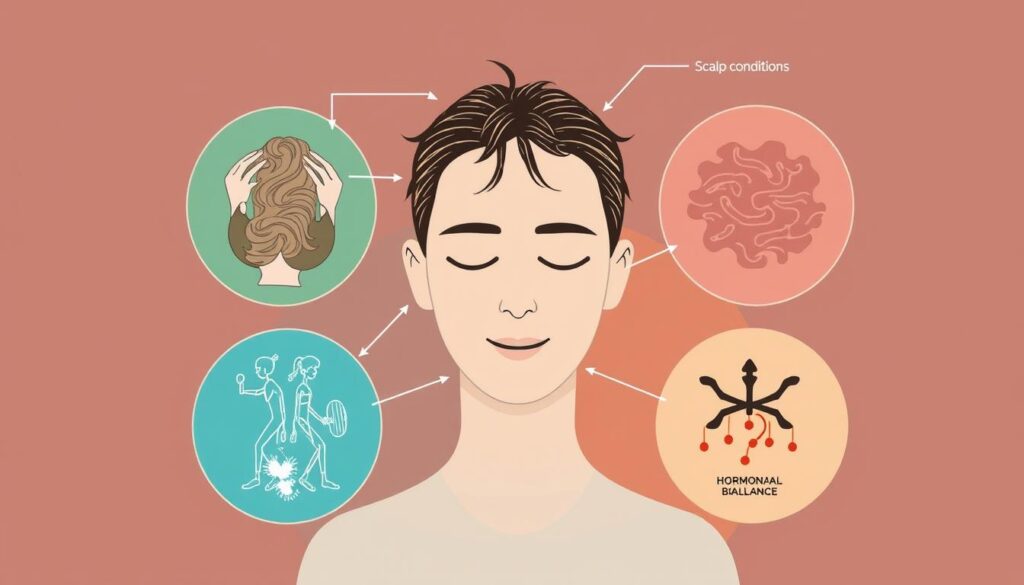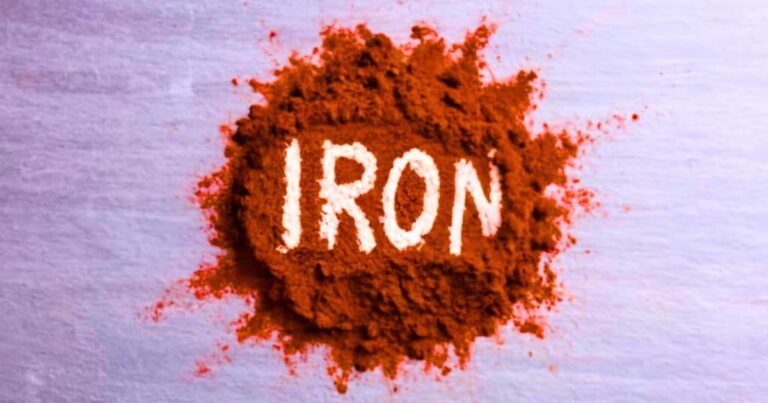Are you dealing with thinning hair or bald spots? You’re not alone. Hair loss is a common issue affecting millions globally. But, there’s hope to find the causes and effective treatments to get your hair back.
This guide explores the complex world of alopecia. It sheds light on the factors leading to hair loss and the therapies to fight it.
Key Takeaways
- Understand the normal hair growth cycle and what constitutes abnormal hair shedding
- Explore the genetic and medical conditions that can lead to different patterns of hair loss
- Discover the role hormones play in affecting hair health and potential treatments
- Learn about the latest medical and natural remedies for addressing the underlying causes of hair loss
- Uncover lifestyle factors and hair care practices that can help minimize further hair loss
Understanding Hair Loss Basics
Hair loss can be upsetting and confusing for many. It’s important to know about the hair growth cycle, normal vs. abnormal shedding, and signs of hair loss.
Normal Hair Growth Cycle
Hair on our heads grows in cycles. It goes through four phases: anagen (growing), catagen (transitional), telogen (resting), and exogen (shedding). About 90% of scalp hair is in the anagen phase, lasting 2 to 8 years.
The other phases last shorter periods. Telogen lasts 2 to 3 months before the hair falls out.
Daily Hair Loss vs. Abnormal Shedding
It’s normal to lose 50 to 100 hairs daily. But, telogen effluvium or anagen effluvium can cause more hair loss. This can happen due to stress, illness, or some medicines.
In these cases, hair loss might be more obvious. It can cause thinning or bald spots on the scalp.
Common Signs and Symptoms
Hair loss can show up in different ways. It might be gradual thinning, circular or patchy bald spots, or sudden hair loosening. Sometimes, it can even lead to losing hair all over the body.
Scaly patches or scalp irritation might also appear. These could be signs of conditions like ringworm.

“Understanding the fundamentals of hair growth and shedding is the first step in addressing any hair loss concerns.”
Genetic Hair Loss Patterns
Androgenetic alopecia, also known as male-pattern baldness or female-pattern baldness, is the most common hair loss type. It’s genetic and can come from either parent. Men often see their hairline recede and may lose hair on top. Women notice thinning hair on the crown of their scalp.
This condition affects over 50 million men and 30 million women in the U.S. Male pattern hair loss starts at the temples and spreads. It can lead to baldness. Female pattern hair loss causes thinning all over, without receding hairlines, as women age.
Genetics play a big role in androgenetic alopecia. It involves over 250 genetic spots linked to severe hair loss. Men get their X chromosome from their mothers, which affects their hair loss risk. Having a family history increases the chance, but it’s not a guarantee.
Androgenetic alopecia shows different patterns and speeds in men and women. About 40% of men will see some baldness by 35, rising to 50% by 50. By 60, 65% are affected, and by 80, 80% have it. Women see 40% with baldness by 50, and 55% by 70.
Knowing the genetic causes and patterns of androgenetic alopecia is key. Early action and tailored plans can fight this common hair loss. It helps keep hair healthy and looking great.
Medical Conditions Leading to Hair Loss
Hair loss can be a sign of many health issues. Knowing the causes is key to treating and managing hair health. Let’s look at some main medical conditions that can cause hair loss.
Alopecia Areata
Alopecia areata is an autoimmune disease. It makes the body attack its own hair follicles, causing sudden hair loss. This can happen on the scalp or other body parts. Getting a quick diagnosis and treatment, like intralesional corticosteroids, is important for managing alopecia areata and helping hair grow back.
Thyroid Disorders
Thyroid hormone imbalances can mess with hair growth, leading to hair loss. Treating the thyroid issue is crucial for hair health.
Scalp Infections
Fungal infections, like ringworm, can cause hair loss on the scalp. Antifungal meds can treat these infections and help hair grow back.
Other conditions that can lead to hair loss include lupus, diabetes, iron deficiency anemia, and PCOS. Treating these conditions is vital for managing hair loss and promoting healthy hair growth.
| Medical Condition | Cause of Hair Loss | Treatment Approach |
|---|---|---|
| Alopecia Areata | Autoimmune disorder attacking hair follicles | Intralesional corticosteroids, immunotherapy |
| Thyroid Disorders | Hormonal imbalances disrupting hair growth cycle | Treatment of underlying thyroid condition |
| Scalp Infections | Fungal infections like ringworm | Antifungal medications |
| Lupus | Autoimmune condition affecting hair follicles | Immunosuppressants, corticosteroids |
| Diabetes | Metabolic changes disrupting hair growth | Management of blood sugar levels |
| Iron Deficiency Anemia | Lack of essential nutrients for hair growth | Iron supplementation |
| PCOS | Hormonal imbalances leading to thinning hair | Treatment of underlying PCOS |
Understanding the medical conditions that lead to hair loss is important. It helps individuals work with their healthcare providers to find the right treatments and restore hair health.

Hormonal Influences on Hair Loss
Hormonal changes greatly affect hair growth. During pregnancy, estrogen levels rise, stopping normal hair shedding. But after childbirth, the estrogen drop leads to pregnancy-related hair loss.
Menopause also brings hormonal shifts, causing hair thinning and shedding. Hormonal imbalances, like in polycystic ovary syndrome (PCOS) or thyroid issues, can lead to hair loss. Some birth control pills can also cause hair loss in those prone to hormonal hair loss.
About 50 million men and 30 million women suffer from hormonal hair loss. The risk grows with age and family history. Associated Dermatologists in Michigan can diagnose and treat hormonal hair loss.

Treating hormonal hair loss often means rebalancing hormones with an endocrinologist’s help. FDA-approved Minoxidil (Rogaine®) can block DHT, a hormone linked to hair loss. Microneedling and PRP therapy can also boost hair growth and stop shedding.
Fixing hormonal imbalances and making lifestyle changes can help. Regular exercise, managing stress, and eating well can support medical treatments and keep hair healthy.
Hair Loss: Causes and Treatments
Understanding Root Causes
Hair loss can stem from many causes, including genetics, medical conditions, and lifestyle. Androgenic alopecia, or hereditary hair loss, affects up to 50% of people. It causes hair thinning in men and women, but differently.
Autoimmune disorders, hormonal changes, and nutritional deficiencies can also lead to hair loss. So can medications, stress, and scalp infections. Knowing the cause helps find the right treatment.
Modern Treatment Options
There are many ways to treat hair loss. Topical minoxidil and oral finasteride can stimulate hair growth. Hair transplant surgery is also an option for those with inherited baldness.
Platelet-rich plasma (PRP) injections use the body’s healing powers to regrow hair. These treatments work best when started early, before a lot of hair is lost.
Treatment Success Rates
Success rates for hair loss treatments vary. Minoxidil can show improvements in 6-12 months. Hair transplants can give permanent results for some.
Starting treatment early is crucial for the best results. Early action can lead to better outcomes.
| Treatment | Success Rate | Typical Timeline |
|---|---|---|
| Minoxidil | 30-60% | 6-12 months |
| Finasteride | 50-60% | 6-12 months |
| Hair Transplant | 90-95% | Permanent |
| PRP Therapy | 60-80% | 3-6 months |

“Early intervention is often the key to achieving the best outcomes when it comes to hair loss treatments.”
Lifestyle Factors Affecting Hair Health
Our daily habits and lifestyle choices greatly affect our hair health. Stress, nutritional deficiencies, and hair care practices all play a role. These factors can change how our hair looks and feels.
Stress Management: Too much stress can cause hair to fall out more. It disrupts the hair growth cycle. Activities like meditation, yoga, or exercise can help reduce stress and protect hair health.
Nutritional Deficiencies: Eating a balanced diet is key for healthy hair. Lack of vitamins and minerals can lead to hair loss. Foods rich in iron, protein, and vitamins A, C, and E are important for hair growth.
Hair Care Habits: How we treat our hair matters a lot. Using too much heat can damage it. Tight hairstyles can also harm the hair and scalp. Using gentle hair care and avoiding harsh chemicals can help keep hair healthy.
By managing stress, eating right, and caring for our hair gently, we can support its health. These steps can make our hair stronger and more vibrant.

Medical Treatments and Solutions
There are many ways to tackle hair loss. You can try prescription drugs, surgery, or alternative therapies. Each method has its own good points and things to watch out for. Let’s look at these hair loss solutions more closely.
Prescription Medications
Prescription drugs are key in fighting hair loss. Drugs like minoxidil (Rogaine), finasteride (Propecia), and spironolactone (Carospir, Aldactone) are common. Minoxidil, used daily by women and twice a day by men, can stop hair loss and even grow new hair. It might take six months to see results.
Finasteride is for men and can slow down hair loss and grow new hair. Dutasteride (Avodart) is also used in some cases.
Surgical Options
Hair transplant surgery is a lasting fix for some. It moves hair follicles from one scalp area to another. This method can look natural but comes with risks like bleeding and swelling. You might need more than one surgery.
Alternative Therapies
There are also new ways to fight hair loss. Low-level laser therapy is approved for hereditary hair loss and can improve hair density. Scalp micropigmentation and PRP injections are also being tried, but their long-term effects are still being studied.
It’s important to talk to a doctor before starting any treatment. They can help pick the best option for you. Each treatment has its own benefits and risks that need to be thought about carefully.
| Treatment | Description | Potential Benefits | Potential Risks |
|---|---|---|---|
| Minoxidil (Rogaine) | Topical medication applied once or twice daily | Can help prevent further hair loss and stimulate new growth | Potential side effects include scalp irritation, unwanted hair growth in other areas |
| Finasteride (Propecia) | Oral medication for men, approved for male pattern hair loss | Can slow down hair loss and promote some new growth | Potential sexual side effects, not recommended for women |
| Hair Transplant Surgery | Surgical procedure that transplants hair follicles from one part of the scalp to another | Can achieve natural-looking results | Risks include bleeding, bruising, swelling, infection, and the potential need for multiple surgeries |
| Low-Level Laser Therapy | Use of low-level lasers or light-emitting diodes to stimulate hair growth | Approved for hereditary hair loss, can improve hair density in some cases | Limited long-term data on effectiveness and safety |
Working with a doctor is key to finding the right hair loss treatment. They can help choose the best option for you based on your needs and goals.
Natural Remedies and Prevention Strategies
Many people use natural remedies and prevention strategies to fight hair loss. These methods aim to fix the root causes and help hair grow strong. They often don’t have the side effects of some medical treatments.
Scalp Massage and Essential Oils
Scalp massages boost blood flow, which helps hair follicles grow. Adding essential oils like rosemary and peppermint can make it even better. Peppermint oil, in particular, can help hair grow by improving scalp circulation.
Dietary Supplements
Dietary supplements are also being looked at for hair loss. Biotin, a B-complex vitamin, is good for hair, skin, and nails. Saw palmetto, a herb, can block DHT, the hormone that causes male pattern baldness.
| Natural Remedy | Potential Benefits |
|---|---|
| Scalp Massage | Increases blood flow to the scalp, promoting hair growth |
| Rosemary and Peppermint Oils | Stimulate hair follicles and improve scalp circulation |
| Biotin Supplements | Support the health of hair, skin, and nails |
| Saw Palmetto | Inhibit the production of DHT, reducing hair loss |
Even though some natural remedies seem promising, the science backing them is not always strong. It’s wise to talk to a healthcare professional before trying them, especially supplements.
Combining natural remedies, prevention strategies, and a healthy lifestyle might be the best way to manage hair loss. This approach can help keep your hair healthy and vibrant.
Hair Care Practices for Minimizing Loss
Proper hair care is key to reducing hair loss and enhancing your hair’s look. Use gentle washing methods, choose smart styling options, and pick the right products. This way, you can keep your hair healthy and full of life.
Proper Washing Techniques
Choose lukewarm water and a mild, gentle hair care shampoo for washing. Hot water can dry out your hair, making it brittle. Massage your scalp gently with your fingertips to boost circulation and hair growth.
Styling Considerations
Think carefully about your hairstyle. Avoid tight styles like ponytails and buns, as they can cause hair loss. Instead, go for volumizing products and loose styles that let your hair breathe.
Product Selection Guidelines
Choose hair care products that match your hair type and needs. For fine or thinning hair, volumizing products can add volume. Also, use heat protection products to protect your hair from hot tools.
By following these hair care tips, you can reduce hair loss and keep your hair looking healthy and vibrant.
Conclusion
Hair loss is a complex issue with many causes and treatments. Knowing the cause is key for effective hair loss management. Many treatments are out there, but results can differ.
Getting advice from a healthcare professional or trichologist is a good idea. They can offer personalized professional advice.
New treatments and improvements in existing ones are being researched. This gives hope to those dealing with hair loss. Medical science is advancing, helping us understand hair loss better.
People can now explore various options to address their hair concerns. This can help them regain confidence in their hair health.
By staying informed and seeking professional help, individuals can manage their hair loss. The journey to healthier, fuller hair may take time and effort. But, the benefits make it worth it.





